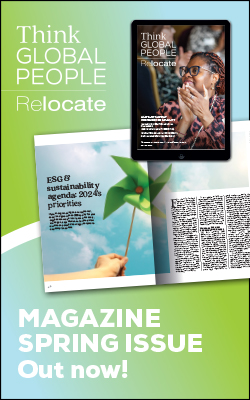Group move planning during Covid-19
Lisa Johnson, Global Practice Leader at Crown World Mobility explores the unique aspects of Group Moves and their challenges in this new reality, including seven essential support activities.

Group Move pitfalls
No one likes to start a review of a Group Move with a list of things that should have been done to help the move meet objectives – “if only we’d known to do them.” Knowledge of the special needs of a Group Move is a critical component, and one that must be started early in the process.- Timing: Missing the timing on planning key elements can derail those who are not experienced in Group Moves. As described above, much has to be done earlier than many would expect, and certainly earlier than what is typical for ongoing employee mobility. Unfortunately, it is not uncommon to hear from Mobility Directors that they are announcing a Group Move next month, and want to know if there is anything special they should be doing to make sure it goes well.
- Policy: Assuming that existing policy – domestic or international – will be used for the Group Move, without considering whether additional or different assistance may be required, is another common pitfall. Just like all mobility policies are designed to meet certain business objectives, Group Move policy needs to be tailored to the desired outcome.
- Research/Staffing: Most HR and Mobility teams are not sufficiently staffed to support a Group Move, with its large scale and intensive time frame. Look outside the organization for research and staffing support to ensure that the company is ready to present the professional level of services needed to achieve its Group Move goals.
- Short cuts: Some companies think they can execute a Group Move without the extras, such as skipping organized events. There is a belief that online information negates the need for this support. However, without guidance, people will go off in their own directions, and may not get the information and perspective they need in the amount of time they have to make a decision. Most businesses would consider this DIY approach too much risk for such a critical event.
- Impacted existing assignee population: Repatriation planning is critical. Often, a weakness in any talent management initiative is magnified in a Group Move environment. Not planning early enough to be able to provide a meaningful approach to employees who must return to their home country, or relocate to another country, can lead to the loss of key talent – something most companies want to go to great lengths to avoid.
- Cross-functional planning: Business situations that necessitate a Group Move are often held close to the vest by senior management – resulting in those who could provide insight on how to make a move successful not being brought in until it is too late. A diverse team of experts within the company, representing affected business lines (Human Resources, facilities management, benefits and, of course, employee mobility), should be brought into the inner circle as early as possible to help ensure that all angles of the move are considered.
Top things to consider to avoid pitfalls
- Developing Group Move specific policy: There are many factors that need to be addressed in a Group Move policy that are not part of an ongoing relocation policy. Policy may need to address the needs of employees for whom the move decision is a choice between keeping or losing a job, rather than accepting an offer or staying in their current position. Families who may not have considered a move before, due to complicated personal factors, may need services that are not typically offered – such as special education support, extended family member assistance or more spouse employment assistance. Different home sale programmes may be needed to address that a greater number of homes in the same community will be on the market simultaneously. Extended temporary living, addressing cost of living differences and special needs for financing are all common elements that may not be part of ongoing relocation policy.
- Communications planning: The impact of an event necessitating a Group Move can have significant consequences on employees, the business and the community. A good communications strategy addresses all aspects of the move, each in its own time. The communications strategy should be in place before the move is announced.
- Implementing move-decision support activities: Making the decision to move to retain a job, when a number of other people are making the same decision, requires a different approach to providing related information. Organized trips to the new location, meetings with local area representatives, counselling regarding policy and timing, and a resource room – real or virtual – are all typical elements of Group Move support, and should be in place when the move is announced.
- Designing an effective retention programmes: Helping those who are moving is one part of the equation; it is equally important to have programmes and policy in place to support those who will not be moving. Even in straightforward situations, employees who are not asked to move, or decide not to move, may be needed during the transition and an effective incentive programme – both financial and support – needs to be developed to ensure business goals are met. Even in situations where the options for attrition-bound employees are clear cut, such as when an expatriate employee must return to their home location, developing an approach that supports repatriation in a timely manner, and addresses reintegration effectively, may require significant time to plan.
- Budgeting: Group Moves are costly endeavours. Whether for relocation, attrition management or business continuity, the HR costs can be significant. Preparing a budget early on can help the business stay on track with the expected costs of the move.
- Finding the right partners: Many aspects of a Group Move require expertise, and lining up appropriate assistance is another aspect to get a jump on. “You don’t know what you don’t know” could be the official Group Move mantra – so why not bring on board those who do know? Destination services providers, real estate professionals, Group Move consultants and relocation management firms all have experience in Group Moves.
- Preparing managers: Managers are the front line of Group Move communications. When the move announcement is made, employees turn to their managers for direction and insight. Preparing managers for this role is key to the success of a Group Move. This is especially challenging when managers are also considering their own move. Preparing managers for the effect of the announcement and the decision-making process is akey step in the planning process. This can include:
- Leading through change
- Clarity on goals/timelines
- Understanding what services will be available and to whom
- Setting expectations on potential productivity dips post-announcement
- Outlining the manager’s role in recruiting and retention goals
- Knowledge of the new location, pros and cons, Cost of Living differences, etc.
- The manager’s own move, if applicable
Subscribe to Relocate Extra, our monthly newsletter, to get all the latest international assignments and global mobility news.
Relocate’s new Global Mobility Toolkit provides free information, practical advice and support for HR, global mobility managers and global teams operating overseas. Access hundreds of global services and suppliers in our Online Directory
Access hundreds of global services and suppliers in our Online Directory
©2024 Re:locate magazine, published by Profile Locations, Spray Hill, Hastings Road, Lamberhurst, Kent TN3 8JB. All rights reserved. This publication (or any part thereof) may not be reproduced in any form without the prior written permission of Profile Locations. Profile Locations accepts no liability for the accuracy of the contents or any opinions expressed herein.
































